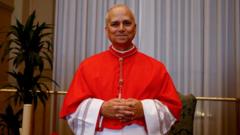As the world awaits the election of a new pope following the passing of Pope Francis, the Vatican's conclave is marked by uncertainty and division among the electing cardinals.
**Papal Election: Black Smoke Signals Delayed Decision in Vatican Conclave**

**Papal Election: Black Smoke Signals Delayed Decision in Vatican Conclave**
Anticipation in St. Peter's Square as Cardinals Conclude Voting without Consensus
The Sistine Chapel once again saw black smoke signaling a failure to reach a consensus on selecting the next Pope during the ongoing conclave on Thursday, as crowds in St. Peter's Square react to the news with disappointment. This marked the second day of secret voting among the 133 cardinals, who were heard in a tense atmosphere, ushered out of the chapel once initial voting was concluded on Wednesday. Amid rolling expectations for a quick resolution akin to previous conclaves which concluded in just two days, the current gathering has turned out to be both historic and potentially lengthy, as cardinals from diverse backgrounds negotiate the future direction of the Catholic Church.
The conclave, which is the first held since Pope Francis’s demise last month, is being conducted in a notably changed political climate. Many of the newer cardinals, appointed by Francis himself, are appearing for the first time alongside one another, which some observers suggest could foster a fragmented decision-making process. Central to their deliberations is the challenge of reconciling the progressive vision espoused by Francis against the expectations of the church's conservative factions, eager to reclaim traditional stances.
In an unprecedented twist, there is much speculation about both candidates’ ages and ideologies, with many cardinals reportedly seeking a balance between youthful vitality and seasoned experience in their new leader. Historical examples illustrate that papal selections aren't constricted by a defined timeline, ranging from quick resolutions to prolonged internal strife, underscoring that the conclusion of this election could vary significantly from previous conclaves.
Cardinals are expected to reconvene for further rounds of voting later Thursday; however, uncertainty remains as to how long their deliberations might last and whether unity can be achieved amid ongoing ideological divides within the church.
In the hearts of many voting cardinals and the crowd gathered outside, there is a collective hope for a leader who embodies compassion and understanding—similar to the legacy left by Pope Francis.
As day transitions into evening, and the day’s votes are tallied, the eyes of the faithful remain fixed on the smoke billowing from the Sistine Chapel, awaiting the telltale sign of white smoke to signal a decision. The world listens closely, knowing that the stakes are high as they anticipate a new chapter for the Catholic Church.
The conclave, which is the first held since Pope Francis’s demise last month, is being conducted in a notably changed political climate. Many of the newer cardinals, appointed by Francis himself, are appearing for the first time alongside one another, which some observers suggest could foster a fragmented decision-making process. Central to their deliberations is the challenge of reconciling the progressive vision espoused by Francis against the expectations of the church's conservative factions, eager to reclaim traditional stances.
In an unprecedented twist, there is much speculation about both candidates’ ages and ideologies, with many cardinals reportedly seeking a balance between youthful vitality and seasoned experience in their new leader. Historical examples illustrate that papal selections aren't constricted by a defined timeline, ranging from quick resolutions to prolonged internal strife, underscoring that the conclusion of this election could vary significantly from previous conclaves.
Cardinals are expected to reconvene for further rounds of voting later Thursday; however, uncertainty remains as to how long their deliberations might last and whether unity can be achieved amid ongoing ideological divides within the church.
In the hearts of many voting cardinals and the crowd gathered outside, there is a collective hope for a leader who embodies compassion and understanding—similar to the legacy left by Pope Francis.
As day transitions into evening, and the day’s votes are tallied, the eyes of the faithful remain fixed on the smoke billowing from the Sistine Chapel, awaiting the telltale sign of white smoke to signal a decision. The world listens closely, knowing that the stakes are high as they anticipate a new chapter for the Catholic Church.























